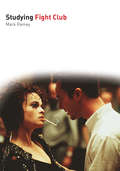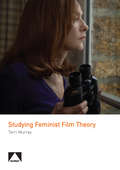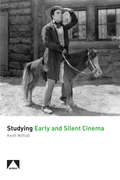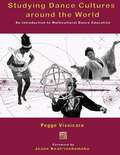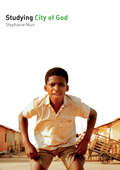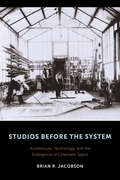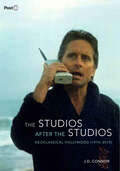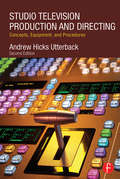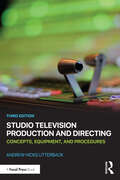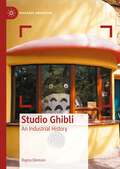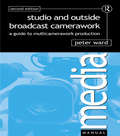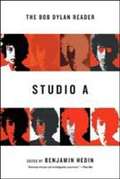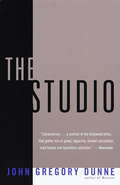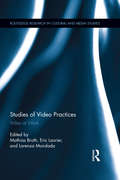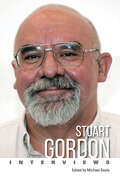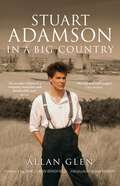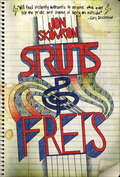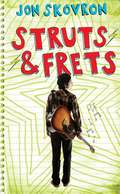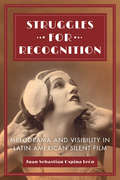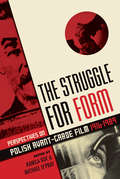- Table View
- List View
Studying Fight Club
by Mark RameyA thoughtful and provocative but also accessible analysis of a pop-culture phenomenon and a deeply philosophical and satirical exploration of modern life.
Studying Feminist Film Theory (Auteur)
by Terri MurrayThis book is aimed at helping media and film studies teachers introduce the basics of feminist film theory. No prior knowledge of feminist theory is required, the intended readers being university undergraduate teachers and students of film and media studies. Areas of emphasis include spectatorship, narrative, and ideology. Many illustrative case studies from popular cinema are used to offer students an opportunity to consider the connotations of visual and aural elements of film, narrative conflicts and oppositions, the implications of spectator “positioning” and viewer identification, and an ideological critical approach to film. Explanations of key terminology are included, along with classroom exercises and practice questions. Each chapter begins with key definitions and explanations of the concepts to be studied, including some historical background where relevant. Case studies include film noir, Kathryn Bigelow’s Strange Days and the work of directors Spike Lee, Claire Denis, and Paul Verhoeven.Studying Feminist Film Theory is a revised and expanded version of Feminist Film Studies: A Teacher’s Guide, published by Auteur in 2007.
Studying Early and Silent Cinema
by Keith WithallIn this accessible introduction to early and silent cinema, which is currently enjoying a renaissance, both academically and in the popular imagination thanks to The Artist, Keith Withall provides both a comprehensive chronology of the period until the birth of sound and also a series of detailed case studies on the key films from the period – some well known (including Griffith's The Birth of a Nation, Eisenstein's Strike and Chaplin's The Kid), some perhaps less well familiar (including Murnau's The Last Laugh and Oscar Micheaux's Within Our Gates). As well as covering in detail the major film-making figures and nations of the period, the author also provides insights into the industry in less well documented areas. Throughout, the films and film-makers are placed in the context of rapid worldwide industrial change. (Please note this book is a revised and expanded version of Early and Silent Cinema: A Teacher's Guide, published by Auteur in 2007.)
Studying Early and Silent Cinema
by Keith WithallA comprehensive chronology of the period until the birth of sound and also a series of detailed case studies on the key films from the period
Studying Early and Silent Cinema
by Keith WithallA comprehensive chronology of the period until the birth of sound and also a series of detailed case studies on the key films from the period
Studying Dance Cultures Around The World: An Introduction To Multicultural Dance Education
by Pegge VissicaroAn introductory textbook for college and university students in dance appreciation and humanities-based courses. This book facilitates the critical examinations of dance in its varied contexts around the world. The objective is to provide a holistic approach that addresses key topics for learning about dance cultures, situated within a broad theoretical framework.
Studying City of God
by Stephanie MuirA leading example of a resurgent Latin American cinema - 'la buena onda' - in the early twenty-first century, City of God was a huge international popular and critical success. A combination of intoxicating, Hollywood-style genre film-making and hard-hitting, social-realist subject matter, it was hailed as a masterpiece at Cannes in 2002 and seen by over 3 million people in Brazil, including the Brazilian cabinet.In Studying City of God, Stephanie Muir considers the historical and industrial context of City of God - a brief history of Latin American cinema is followed by a more detailed account of film-making in Brazil - from light-hearted travelogues to Cinema Novo and after - all in the context of increasing globalisation. She analyzes narrative and genre - how the film uses the components of narrative in a complex way, experimentally manipulating time while using traditional genre conventions that are highly recognisable to mainstream audiences. The formal elements of the film are dissected through a detailed illustrated analysis of the kinetic, scene setting opening sequence. She also discusses audience responses - from establishment critical reaction to fan-based Internet sites and student feedback - and issues of representation and ideology - just how 'authentic' can a film such as City of God hope to be? Does its style overwhelm its subject matter?
Studying City of God (Studying Films)
by Stephanie MuirA leading example of a resurgent Latin American cinema – 'la buena onda' – in the early twenty-first century, City of God was a huge international popular and critical success. A combination of intoxicating, Hollywood-style genre film-making and hard-hitting, social-realist subject matter, it was hailed as a masterpiece at Cannes in 2002 and seen by over 3 million people in Brazil, including the Brazilian cabinet.In Studying City of God, Stephanie Muir considers the historical and industrial context of City of God – a brief history of Latin American cinema is followed by a more detailed account of film-making in Brazil – from light-hearted travelogues to Cinema Novo and after – all in the context of increasing globalization. She analyzes narrative and genre – how the film uses the components of narrative in a complex way, experimentally manipulating time while using traditional genre conventions that are highly recognizable to mainstream audiences. The formal elements of the film are dissected through a detailed illustrated analysis of the kinetic, scene setting opening sequence. She also discusses audience responses – from establishment critical reaction to fan-based Internet sites and student feedback – and issues of representation and ideology – just how 'authentic' can a film such as City of God hope to be? Does its style overwhelm its subject matter?
Studios Before the System: Architecture, Technology, and the Emergence of Cinematic Space (Film and Culture Series)
by Brian JacobsonBy 1915, Hollywood had become the epicenter of American filmmaking, with studio "dream factories" structuring its vast production. Filmmakers designed Hollywood studios with a distinct artistic and industrial mission in mind, which in turn influenced the form, content, and business of the films that were made and the impressions of the people who viewed them. The first book to retell the history of film studio architecture, Studios Before the System expands the social and cultural footprint of cinema's virtual worlds and their contribution to wider developments in global technology and urban modernism.Focusing on six significant early film corporations in the United States and France—the Edison Manufacturing Company, American Mutoscope and Biograph, American Vitagraph, Georges Méliès's Star Films, Gaumont, and Pathé Frères—as well as smaller producers and film companies, Studios Before the System describes how filmmakers first envisioned the space they needed and then sourced modern materials to create novel film worlds. Artificially reproducing the natural environment, film studios helped usher in the world's Second Industrial Revolution and what Lewis Mumford would later call the "specific art of the machine." From housing workshops for set, prop, and costume design to dressing rooms and writing departments, studio architecture was always present though rarely visible to the average spectator in the twentieth century, providing the scaffolding under which culture, film aesthetics, and our relation to lived space took shape.
The Studios after the Studios: Neoclassical Hollywood (1970-2010)
by J. D. ConnorModern Hollywood is dominated by a handful of studios: Columbia, Disney, Fox, Paramount, Universal, and Warner Bros. Threatened by independents in the 1970s, they returned to power in the 1980s, ruled unquestioned in the 1990s, and in the new millennium are again beseiged. But in the heyday of this new classical era, the major studios movies — their stories and styles — were astonishingly precise biographies of the studios that made them. Movies became product placements for their studios, advertising them to the industry, to their employees, and to the public at large. If we want to know how studios work—how studios think—we need to watch their films closely. How closely? Maniacally so. In a wide range of examples, The Studios after the Studios explores the gaps between story and backstory in order to excavate the hidden history of Hollywood's second great studio era.
Studio Television Production and Directing: Concepts, Equipment, and Procedures
by Andrew UtterbackMaster the fundamentals of studio production procedure and become an effective leader on set. Gain fluency in essential studio terms and technology and acquire the skills you need to make it in the industry. Elegant, accessible, and to the point, the second edition of Andrew H. Utterback’s Studio Television Production and Directing is your back-to-the-basics guide to studio-based lighting, set design, camera operations, floor direction, technical direction, audio capture, graphics, prompting, and assistant directing. Whether you are an established studio professional or a student looking to enter the field, this book provides you with the technical expertise you need to successfully coordinate live or taped studio television in the digital age. This new edition has been updated to include: A UK/Euro focused appendix, enhancing the book’s accessibility to students and professionals of television production around the world An advanced discussion of the job of the Director and the Command Cue Language Fresh discussion of tapeless protocols in the control room, Media Object Server newsroom control software (iNews), editing systems, switcher embedded image store, and DPM (DVE) Brand new sections on UHDTV (4K), set design, lighting design, microphones, multiviewers, media asset management, clip-servers, and the use of 2D and 3D animation Expanded coverage of clip types used in ENG and video journalism (VO, VO/SOT, and PKG) An all new companion website (www.focalpress.com/cw/utterback) with pre-recorded lectures by the author, sample video clips, an expanded full color image archive, vocabulary flashcards, and more Note: the companion website is still under development, but in the meantime the author's filmed lectures are all freely available on Youtube: https://www.youtube.com/channel/UCRp_aSpO0y8cDqLjFGZ2s9A
Studio Television Production and Directing: Concepts, Equipment, and Procedures
by Andrew Hicks UtterbackThis updated third edition of Studio Television Production and Directing introduces readers to the basic fundamentals of studio and control room production. Accessible and focused, readers of this updated third edition will learn about essential studio and control room terminology and the common technology package. This book is your back-to-the-basics guide to common technology—including principles of directing, assistant directing, technical directing, playback, audio ops, basic studio lighting, an introduction to set design, camera ops, floor directing, story types (VO, VO/SOT, PKG), basic engineering, and more. Whether an established professional or a student, this book provides readers with the technical expertise to successfully coordinate live or recorded multicamera production. In this new edition, author Andrew Hicks Utterback offers an expanded glossary and new material on visualization walls, alternative camera mounts, basic engineering, and news narrative diagramming.
Studio Ghibli: An Industrial History (Palgrave Animation)
by Rayna DenisonStudio Ghibli: An Industrial History takes us deep into the production world of the animation studio co-founded by Oscar-winning director Hayao Miyazaki. It investigates the production culture at Studio Ghibli and considers how the studio has become one of the world’s most famous animation houses. The book breaks with the usual methods for studying Miyazaki and Ghibli’s films, going beyond textual analysis to unpack the myths that have grown up around the studio during its long history. It looks back at over 35 years of filmmaking by Miyazaki and other Ghibli directors, reconsidering the studio’s reputation for egalitarianism and feminism, re-examining its relationship to the art of cel and CG animation, investigating Studio Ghibli’s work outside of feature filmmaking from advertising to videogames and tackling the studio’s difficulties in finding new generations of directors to follow in the footsteps of Miyazaki and Isao Takahata. By reconstructing the history of Studio Ghibli through its own records, promotional documents and staff interviews, Studio Ghibli: An Industrial History offers a new perspective not just on Ghibli, but on the industrial history of Japanese animation.
Studio and Outside Broadcast Camerawork: A Guide To Multi-camerawork Production
by Peter WardStudio and outside broadcast is often done with more than one camera and has its own distinct discipline and operational procedures. Many camera operators now start with single camera operations and have little or no experience of the skills required for multi-camera operation, whereas it used to be the other way round. This book prepared newcomers to multi-camerawork and the techniques required to produce professional results. Studio and Outside Broadcast Camerawork is a revised edition of Multi-Camera Camerawork, including new material on widescreen shooting and an update on BBC (and worldwide) policy of 'shoot and protect' for dual aspect ratio format production.
Studio A: The Bob Dylan Reader
by Benjamin HedinThis book presents Bob Dylan's unique literary legacy in a collection that gathers over fifty articles, poems, essays, speeches, literary criticisms, and interviews; many previously unpublished.
The Studio
by John Gregory DunneIn 1967, John Gregory Dunne asked for unlimited access to the inner workings of Twentieth Century Fox. Miraculously, he got it. For one year Dunne went everywhere there was to go and talked to everyone worth talking to within the studio. He tracked every step of the creation of pictures like "Dr. Dolittle," "Planet of the Apes," and "The Boston Strangler." The result is a work of reportage that, thirty years later, may still be our most minutely observed and therefore most uproariously funny portrait of the motion picture business.Whether he is recounting a showdown between Fox's studio head and two suave shark-like agents, watching a producer's girlfriend steal a silver plate from a restaurant, or shielding his eyes against the glare of a Hollywood premiere where the guests include a chimp in a white tie and tails, Dunne captures his subject in all its showmanship, savvy, vulgarity, and hype. Not since F. Scott Fitzgerald and Nathanael West has anyone done Hollywood better."Reads as racily as a novel...(Dunne) has a novelist's ear for speech and eye for revealing detail...Anyone who has tiptoed along those corridors of power is bound to say that Dunne's impressionism rings true."--Los Angeles Times
Studies of Video Practices: Video at Work (Routledge Research in Cultural and Media Studies #63)
by Mathias Broth Eric Laurier Lorenza MondadaThe last two decades have seen a rapid increase in the production and consumption of video by both professionals and amateurs. The near ubiquity of devices with video cameras and the rise of sites like YouTube have lead to the growth and transformation of the practices of producing, circulating, and viewing video, whether it be in households, workplaces, or research laboratories. This volume builds a foundation for studies of activities based in and around video production and consumption. It contributes to the interdisciplinary field of visual methodology, investigating how video functions as a resource for a variety of actors and professions.
Stuart Gordon: Interviews (Conversations with Filmmakers Series)
by Michael DoyleAnimated by a singularly subversive spirit, the fiendishly intelligent works of Stuart Gordon (1947–2020) are distinguished by their arrant boldness and scab-picking wit. Provocative gems such as Re-Animator, From Beyond, Dolls, The Pit and the Pendulum, and Dagon consolidated his fearsome reputation as one of the masters of the contemporary horror film, bringing an unfamiliar archness, political complexity, and critical respect to a genre so often bereft of these virtues. A versatile filmmaker, one who resolutely refused to mellow with age, Gordon proved equally adept at crafting pointed science fiction (Robot Jox, Fortress, Space Truckers), sweet-tempered fantasy (The Wonderful Ice Cream Suit), and nihilistic thrillers (King of the Ants, Edmond, Stuck), customarily scrubbing the sharply drawn lines between exploitation and arthouse cinema.The first collection of interviews ever to be published on the director, Stuart Gordon: Interviews contains thirty-six articles spanning a period of fifty years. Bountiful in anecdote and information, these candid conversations chronicle the trajectory of a fascinating career—one that courted controversy from its very beginning. Among the topics Gordon discusses are his youth and early influences, his founding of Chicago’s legendary Organic Theatre (where he collaborated with such luminaries as Ray Bradbury, Kurt Vonnegut, and David Mamet), and his transition into filmmaking where he created a body of work that injected fresh blood into several ailing staples of American cinema. He also reveals details of his working methods, his steadfast relationships with frequent collaborators, his great love for the works of Lovecraft and Poe, and how horror stories can masquerade as sociopolitical commentaries.
Stuart Adamson: In a Big Country
by Glen AllanA music journalist and fan examines the life and work of the Scottish guitarist, vocalist, and songwriter. The book that fans of the Skids, Big Country and the Raphaels have been waiting for—a critical perspective not only of Adamson&’s music and its wider cultural influence, but also the excesses of fame and how the music business really works. Stuart Adamson: In A Big Country tells the story of how a teenager who was raised in a small Fife village released his first single at 19, wrote three Top 40 albums in the next three years and was written off as a has-been at 23, but then went on to form a new band and sell more than 10 million records worldwide, touring with the Rolling Stones and David Bowie. Although Adamson was one of the most respected and popular figures in the music industry, his personal life was complex and ultimately tragic, ending with his alcohol-fueled suicide in a Hawaiian hotel in December, 2001.&“He was a massive, massive influence on me . . . Absolute genius.&” —James Dean Bradfield, Manic Street Preachers&“An overdue tribute to a visionary musician and honorable man.&” —Keith Cameron, Mojo&“Engaging journey through the peaks and troughs of an ultimately troubled life . . . Moving and well-judged.&” —Rob Hughes, The Word
Struts & Frets
by Jon SkovronMusic is in Sammy’s blood. His grandfather was a jazz musician, and Sammy’s indie rock band could be huge one day—if they don’t self-destruct first. Winning the upcoming Battle of the Bands would justify all the band’s compromises and reassure Sammy that his life’s dream could become a reality. But practices are hard to schedule when Sammy’s grandfather is sick and getting worse, his mother is too busy to help either of them, and his best friend may want to be his girlfriend. When everything in Sammy’s life seems to be headed for major catastrophe, will his music be enough to keep him together?
Struts and Frets
by Jon SkovronTold in a voice that's honest, urgent, and hilarious, "Struts and Frets" is a bright debut novel about forming a band, falling in love, and facing the truth.
Struggles for Recognition: Melodrama and Visibility in Latin American Silent Film
by Juan Sebastián Ospina LeónStruggles for Recognition traces the emergence of melodrama in Latin American silent film and silent film culture. Juan Sebastián Ospina León draws on extensive archival research to reveal how melodrama visualized and shaped the social arena of urban modernity in early twentieth-century Latin America. Analyzing sociocultural contexts through film, this book demonstrates the ways in which melodrama was mobilized for both liberal and illiberal ends, revealing or concealing social inequities from Buenos Aires to Bogotá to Los Angeles. Ospina León critically engages Euro-American and Latin American scholarship seldom put into dialogue, offering an innovative theorization of melodrama relevant to scholars working within and across different national contexts.
The Struggle for Form
by Kamila KucThis is the first comprehensive English-language account of the Polish avant-garde film, from its beginnings in the early decades of the last century to the collapse of communism in 1989. Taking a broad understanding of avant-garde film, this collection includes writings on the pioneering work of the internationally-acclaimed Franciszka and Stefan Themerson; the Polish Futurists' (Jalu Kurek, Anatol Stern) engagement with film; the Thaw and animation (Jan Lenica and Walerian Borowczyk, Andrzej Pawlowski, Zbigniew Rybczynski); documentary (Natalia Brzozowska, Kazimierz Karabasz, Wojciech Wiszniewski), Polish émigré filmmakers (Roman Polanski, Jerzy Skolimowski, Andrzej Zulawski) as well as essays and documentation on the highly influential Film Form Workshop (Józef Robakowski, Ryszard Wasko, Wojciech Bruszewski). Including a mix of historical writings from early film magazines with commissioned essays, this book constitutes an important source on the rich, complex and diverse history of the Polish film avant-garde, which is presented from the perspective of both British (A. L. Rees, Jonathan Owen, Michael O'Pray) and Polish (Marcin Gizycki, Ryszard Kluszczynski, Kamila Kuc) authorities on the subject. This book is thus an indispensable introduction to the theories and practices of critically important avant-garde artists and filmmakers.
The Struggle for Form
by Kamila KucThis is the first comprehensive English-language account of the Polish avant-garde film, from its beginnings in the early decades of the last century to the collapse of communism in 1989. Taking a broad understanding of avant-garde film, this collection includes writings on the pioneering work of the internationally-acclaimed Franciszka and Stefan Themerson; the Polish Futurists' (Jalu Kurek, Anatol Stern) engagement with film; the Thaw and animation (Jan Lenica and Walerian Borowczyk, Andrzej Pawlowski, Zbigniew Rybczynski); documentary (Natalia Brzozowska, Kazimierz Karabasz, Wojciech Wiszniewski), Polish émigré filmmakers (Roman Polanski, Jerzy Skolimowski, Andrzej Zulawski) as well as essays and documentation on the highly influential Film Form Workshop (Józef Robakowski, Ryszard Wasko, Wojciech Bruszewski). Including a mix of historical writings from early film magazines with commissioned essays, this book constitutes an important source on the rich, complex and diverse history of the Polish film avant-garde, which is presented from the perspective of both British (A. L. Rees, Jonathan Owen, Michael O'Pray) and Polish (Marcin Gizycki, Ryszard Kluszczynski, Kamila Kuc) authorities on the subject. This book is thus an indispensable introduction to the theories and practices of critically important avant-garde artists and filmmakers.
The Struggle for Form: Perspectives on Polish Avant-Garde Film, 1916–1989
by Kuc Kamila O’Pray Michael Eds.This is the first comprehensive English-language account of the Polish avant-garde film, from its beginnings in the early decades of the last century to the collapse of communism in 1989. Taking a broad understanding of avant-garde film, this collection includes writings on the pioneering work of the internationally-acclaimed Franciszka and Stefan Themerson; the Polish Futurists' (Jalu Kurek, Anatol Stern) engagement with film; the Thaw and animation (Jan Lenica and Walerian Borowczyk, Andrzej Pawlowski, Zbigniew Rybczynski); documentary (Natalia Brzozowska, Kazimierz Karabasz, Wojciech Wiszniewski), Polish émigré filmmakers (Roman Polanski, Jerzy Skolimowski, Andrzej Zulawski) as well as essays and documentation on the highly influential Film Form Workshop (Józef Robakowski, Ryszard Wasko, Wojciech Bruszewski). Including a mix of historical writings from early film magazines with commissioned essays, this book constitutes an important source on the rich, complex and diverse history of the Polish film avant-garde, which is presented from the perspective of both British (A. L. Rees, Jonathan Owen, Michael O'Pray) and Polish (Marcin Gizycki, Ryszard Kluszczynski, Kamila Kuc) authorities on the subject. This book is thus an indispensable introduction to the theories and practices of critically important avant-garde artists and filmmakers.
